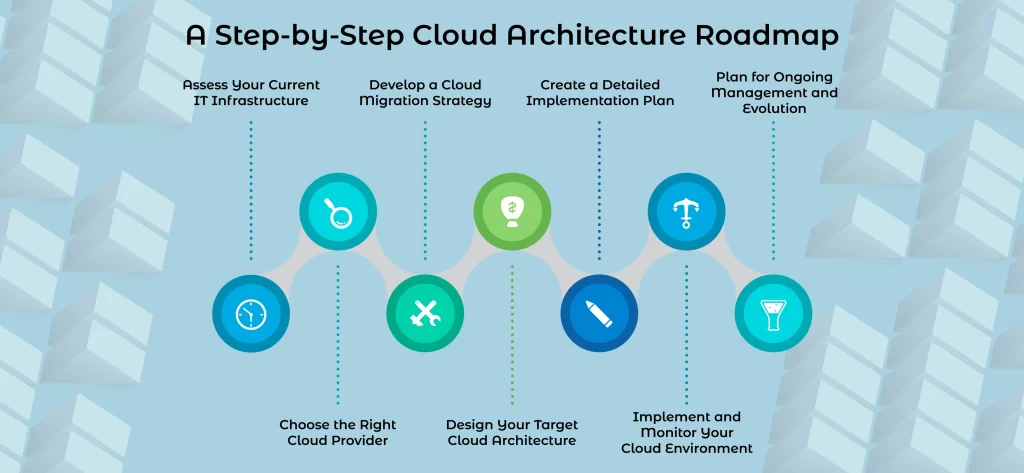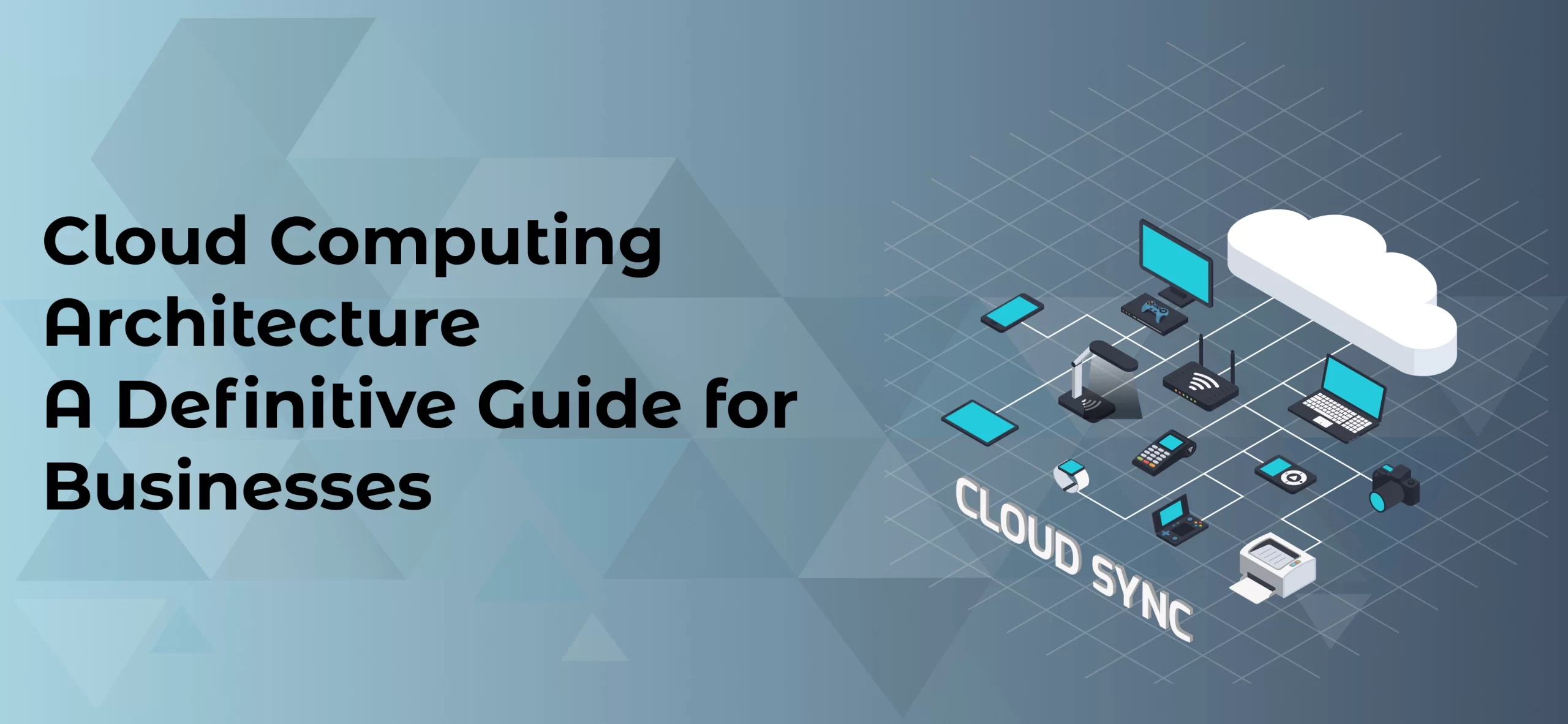Imagine a world in which your business could instantly scale to handle unexpected spikes in demand, access cutting-edge software without large upfront investments and protect its sensitive data in an entirely secure environment – this reality powered by cloud computing architecture components today and over 90% of businesses already leverage its services in some way or form, underscoring its unquestionable impact in modern businesses.
Cloud computing architecture refers to the foundational blueprint that organizes how various cloud resources – like servers, storage, networks and software – come together and function together online. Think of it like the complex infrastructure of a city with roads, power grids and buildings all working cohesively or perhaps like the blueprint of an office building showing each room connecting together into one cohesive unit; understanding this fundamental structure of cloud computing architecture is integral for businesses looking to capitalize on all that the cloud offers them.
This comprehensive guide to cloud computing architecture will delve into its fundamental principles, its core components, deployment models and considerations for your business. By the time it ends, you’ll have an in-depth knowledge of how cloud works behind-the-scenes, as well as ways in which its power can benefit your organization’s bottom line.
Fundamental Building Blocks of Cloud Architecture
For an understanding of cloud computing for businesses, it’s crucial to break it down into its essential parts. Each component works cohesively together to deliver robust yet versatile services that businesses rely on from cloud environments.
Front End (UI)
The front-end is the part of cloud architecture which users interact directly with; it acts as the interface for accessing and using services provided through it. Common examples may include:
- Web Browsers: Allow accessing of web-based applications and cloud platforms.
- Client Applications: Software installed on devices (computers or laptops) which communicates with cloud services via the internet.
- Mobile applications: Applications designed specifically for smartphones and tablets that utilize cloud functionality.
Back-End: The Core Infrastructure
Behind its user-friendly front end lies a robust back end – the engine of cloud services – with key components including these for heavy lifting:
- Servers: Cloud servers store data and run applications remotely and can range in form from desktop computers, notebook computers or virtual server instances. They may include:
- Physical servers: Dedicate physical resources, while virtual servers: Software-based simulations that offer greater efficiency and flexibility than their real life counterparts.
- Storage Options in the Cloud: With various cloud-based options offering storage solutions tailored specifically for various storage requirements.
- Object storage: Ideal for storing large volumes of unstructured data like images, videos and documents (e.g. AWS S3).
- Block storage: Block storage provides raw block-level access to storage devices, making it suitable for databases and virtual machines (for instance AWS EBS).
- File storage: allows users to access information through an intuitive file structure similar to traditional storage (for instance AWS EFS).
- Networking: This refers to the infrastructure which facilitates communications within and between clouds and users, such as communication among their cloud infrastructure components and between clouds themselves and users. Key components may include:
- Routers: Provide data connectivity between networks by routing traffic.
- Switches: Connect devices within a network.
- Load balancers: Distributing traffic across multiple servers to maximize performance and availability is what load balancers do best.
- Firewalls: Protect the cloud environment from unwarranted access with firewalls.
- Database Solutions in the Cloud: Cloud services offer numerous database storage and management options that make data management simple:
- Relational databases: Organization of data in tables that share relationships (e.g. MySQL or PostgreSQL in the cloud).
- NoSQL databases: Used for handling unstructured or semi-structured data with ease and flexibility (e.g. MongoDB and Cassandra on cloud).
Cloud Service Models: the “as-a-Service” Spectrum
Cloud computing services come in different models, each offering differing levels of control and accountability – often known as “as-a-Service” models.
- Infrastructure as a Service (IaaS): With IaaS, users gain access to key elements of IT infrastructure – servers, storage devices and networking. You essentially rent this resource from a cloud provider. Example include AWS Elastic Compute Cloud and Azure Virtual Machines, Google Compute Engine
- Business Benefits: Infrastructure as a Service offers tremendous flexibility and control, giving users control over operating system, applications and infrastructure – which allows you to tailor it according to specific business requirements – making IaaS particularly advantageous for complex or unique requirements.
- Platform as a Service (PaaS): PaaS provides developers with an application development, deployment, and management environment; the cloud provider oversees infrastructure needs so coders can focus on writing code alone. Example are AWS Elastic Beanstalk, Azure App Service, and Google App Engine
- Business Benefits: PaaS helps accelerate development cycles while decreasing management overhead costs, so developers can focus on building applications without worry over infrastructure maintenance issues – an especially advantageous feature of enterprise cloud solutions which require swift creation and deployment processes.
- Software as a Service (SaaS): With this model, cloud providers deliver preloaded apps directly over the internet for use by individuals through web browsers or mobile applications – without worrying about infrastructure management, updates or maintenance needs. Examples: Gmail, Salesforce and Microsoft 365.
- Business Benefits: It offers easy access and lower upfront costs, no software installation and maintenance need, making SaaS an attractive cost-cutting strategy.
Building a Cloud Architecture Roadmap for Your Business

Kickstarting a cloud journey requires careful consideration and an established roadmap, to ensure its smooth implementation while realizing maximum benefits with minimum disruptions. Here is an outline of key steps involved in developing an architecture roadmap for your company:
Assessment of Your Current IT Infrastructure
As the initial crucial step, analyzing your existing IT infrastructure requires documenting its hardware, software applications, data storage needs, networking capacities and operational processes. Determine your current workloads, their performance requirements, dependencies and pain points or limitations.
Understanding your current state provides a baseline for comparison and helps identify which workloads would most benefit from being housed on a cloud, informing future cloud architecture designs. Furthermore, such an assessment will reveal your security posture and compliance needs that need to be considered when reviewing cloud infrastructure services and related cloud storage and security offerings.
Choose the Right Cloud Provider
Selecting an ideal cloud provider is of vital importance, with various providers offering various infrastructure services, pricing models, service level agreements (SLAs), and geographic coverage options to suit every business’ unique requirements. Assess potential vendors based on your individual business requirements, technical specs, security standards, compliance certifications and budget constraints.
Consider factors like your provider’s track record, ecosystem of services offered, ease of integration with existing systems and level of support available before selecting one as your service provider.
Enterprise cloud solutions require finding a provider with proven ability to manage complex workloads and meet stringent security requirements, while simultaneously understanding all available deployment models such as public, private hybrid multicloud etc. At this stage, it is also crucial that providers understand which deployment models might best meet those requirements (public private hybrid multi-cloud etc).
Develop a Cloud Migration Strategy
Once you’ve selected your provider, a comprehensive cloud migration strategy should be in place. Determine what applications and data will be migrated, their order, the method you will employ (lift-and-shift, deplatforming or reconstructing), as well as any necessary requirements (i.e. firewall configuration or data storage requirements).
Consider the complexity, dependencies, and potential impact of each migration approach on your business operations before creating your migration strategy. A well-crafted migration plan minimizes downtime while maintaining data integrity during transition and quickly reaping the advantages of cloud computing. It should address data migration timelines, potential rollback plans and necessary skills and resources required for successful migrations.
Design Your Target Cloud Architecture
In this step, the specific architecture for your cloud environment must take into account business requirements, application needs and the capabilities of the chosen provider. As part of your design strategy, select appropriate cloud infrastructure services (compute, storage and networking), database solutions, security controls and application services based on factors like scaleability, performance availability cost efficiency security.
When developing your target architecture, consider factors like scaleability availability cost efficiency security scalability. Enterprise cloud solutions require complex, multi-tiered architectures capable of accommodating high volumes of traffic and data while adhering to stringent security and compliance standards. Your design should take account of how different environments will interact, with consideration given for cloud deployment models you select as well.
Create a Detailed Implementation Plan
Once your target architecture has been determined, the next step should be creating an in-depth implementation plan. This document should outline all tasks, timelines, responsibilities and resources necessary for building and deploying your cloud environment – this may include configuration steps, security hardening measures, data migration procedures, testing protocols or user training protocols – with detailed steps as necessary in each category to guarantee an error-free deployment process and minimize delays or errors during deployment; furthermore it should incorporate best practices for cloud storage security from its inception as part of its design.
Implement and Monitor Your Cloud Environment
In this phase, deployment and configuration of your cloud infrastructure according to its implementation plan takes place. Once operationalized, ongoing monitoring should take place to ensure its performance, availability, and security – including tracking key metrics to proactively identify issues as soon as they arise and adherence with service level agreements (SLA). Effective monitoring is the cornerstone of cloud computing’s scalability and reliability advantages.
Plan for Ongoing Management and Evolution
Your cloud journey doesn’t end once implementation has taken place – you must also devise an ongoing management, maintenance, and evolution strategy for it to remain productive over time. This involves regular security updates, performance optimizations, cost control measures, capacity planning measures as well as adapting its architecture in response to shifting business needs or technological advancements.
Typically, enterprise cloud solutions implement dedicated cloud operations teams as well as robust governance frameworks – while continually reviewing new cloud services while optimising storage practices can maximize returns on your cloud investment over time.
Conclusion
Understanding cloud computing architecture has become an indispensable element of business success in our digital era, not simply an additional technical consideration. We explored its essential building blocks, diverse service delivery models and key considerations that underlie an effective cloud strategy. A well-defined cloud architecture tailored to meet your requirements serves as the cornerstone for building agility, scalability, efficiency and security into operations – so ignoring it risks costly errors, bottlenecks or missed opportunities in operation.
Echoinnovate IT offers your organization everything it needs to craft an efficient future-ready cloud strategy, from initial assessment and architecture design, through migration and ongoing management, with our certified professionals offering guidance at every stage. They can assist with cloud infrastructure services, optimising storage capacity and security needs as well as devising custom tailored solutions designed to foster innovation and growth for your organization. Contact Echoinnovate IT now for a consultation to start shaping its success on cloud platforms!
Cloud Computing Architecture: A Definitive Guide for Businesses
What is cloud computing architecture and why is it important for businesses?
Cloud computing architecture refers to the components and subcomponents required for cloud computing, including front-end platforms, back-end platforms (servers and storage), cloud-based delivery, and a network. It is crucial for businesses because it enables scalable, cost-effective, and flexible IT infrastructure, allowing companies to access computing resources on demand, improve collaboration, and accelerate innovation without large upfront investments in hardware.
What are the main components of cloud computing architecture?
The main components include:
Front-End: The client side interface (web browsers, applications).
Back-End: Servers, storage, databases, and applications that process and store data.
Cloud Delivery Models: IaaS, PaaS, SaaS depending on service level.
Network: Connects everything and ensures secure data transmission.
How does cloud architecture support business scalability?
Cloud architecture allows businesses to scale resources up or down based on demand. This elasticity helps avoid over-provisioning, reduces costs, and ensures optimal performance during peak usage times, making it ideal for growing or seasonal businesses.



